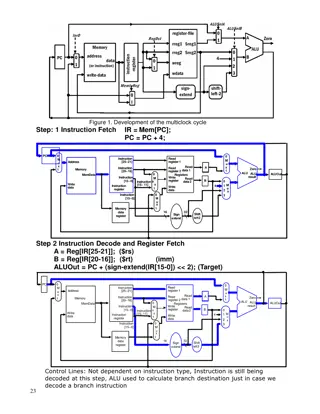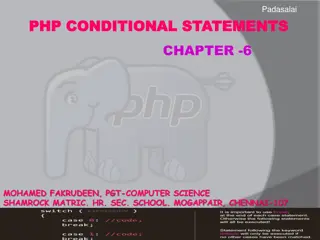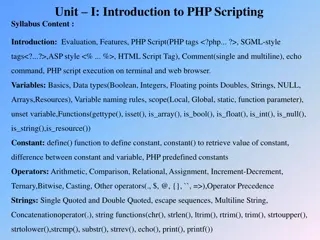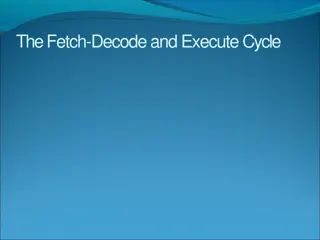
Method for Implementing Fraction Addition in C++
Learn the step-by-step implementation of fraction addition in C++, including methods for reducing fractions to their simplest form and adding two fractions together. The tutorial provides insights on constructor implementation, as well as key functions like gcd and reduce.
Download Presentation

Please find below an Image/Link to download the presentation.
The content on the website is provided AS IS for your information and personal use only. It may not be sold, licensed, or shared on other websites without obtaining consent from the author. If you encounter any issues during the download, it is possible that the publisher has removed the file from their server.
You are allowed to download the files provided on this website for personal or commercial use, subject to the condition that they are used lawfully. All files are the property of their respective owners.
The content on the website is provided AS IS for your information and personal use only. It may not be sold, licensed, or shared on other websites without obtaining consent from the author.
E N D
Presentation Transcript
Data Structures TA Session #1 By Hung-Chih & Carlos 106/10/16
Preface Few things before we start
When doing your homework 1. Write in nice & clear format. 2. Remember to write down your student ID and name. 3. Use A4-size sheets. 4. Answer each question one by one. 5. DoNOT handin yourhomeworkin sheets unstapled. 6. Use the International Edition.
More than homework 1. Think more situations while writing programs. 2. What should you get after this class?
Assignment #1 Average score = 54.3
Problem 1-2 Fraction addition
Part B. C++ implementation Class Fraction { private: int N, D, M = 1; int GCD(int a, int b); public: Fraction(int , int); Fraction add(const Fraction); void reduce(); }
/* GCD on nominator and denominator */ int Fraction::gcd(int a, int b) { if(a % b == 0) return b; else return gcd(b, a%b); }
/* Reduce the fraction to the simple form */ void reduce() { if(N) { g = gcd( N, D ); N = N / g; D = D / g; } }
Part B. C++ implementation /* Constructor */ Fraction::Fraction (int n, int d) { if (n * d < 0) M = -1; if (!d) throw Denominator should not be 0! if (!n) d = 1 N = abs(n); D = abs(d); reduce(); }
Part B. C++ implementation /* Add 2 fractions */ Fraction::Fraction add(const Fraction addEnd) { Fraction sum(N * M * addEnd.D + addEnd.N * D, D * addEnd.D) return sum; }
Problem 1-3 The appointment book
Part A. change purpose of a appointment /* This is a pseudocode, not C++, function. * Appointment book is implemented in ADT * Please do not compile this code * * No new function is required. (But if you treat the following * as a new function, that's also ok.) * This function uses existing functions like isAppointment, * cancelAppointment, and makeAppointment. */
// Change the purpose of an appointment updatePurpose( date: Date, time: Time, newPurpose: String ) { // Make sure the appointment exists if ( apptBook.isAppointment( date, time ) ) { // The appointment does exist apptBook.cancelAppointment( date, time ); if( apptBook.makeAppointment( date, time, newPurpose ) ) write( Purpose of the appointment updated." ); } else // The appointment doesn't exist write( "No appointment at the given date & time." ); }
Part B. list all appointments in a day /* * No new function is required. (But if you treat the following * as a new function, that's also ok.) * This function uses existing functions like isAppointment, getAppointmentPurpose. */
Part B. list all appointments in a day // Print all appointments for a given date getDateAppointment( apptDate: Date ) { // Iterate through all possible times on the given day for (each time) time enum // If the appointment exists if ( apptBook.isAppointment( date, time ) ) write( apptBook.getAppointmentPurpose( date, time ), " at ", date, time ); }
Problem 1-5 Remove elements in a bag & Javadoc comment style
Javadoc comment style Look at https://en.wikipedia.org/avadoc Begins with /** and ends with */ @param @return No blank lines between comment and code body Paragraphs in comment are separated by <p>
#include<bits/stdc++.h> using namespace std; /** * Class bag --- simulation of a bag of strings * Note that this problem asks you to comment in Javadoc style, so * please DO comment your functions, or you'll lose some marks. * <p> * Also, use `<p>' to separate paragraphs between descriptions when * needed, and there s no blank lines between comment & function.
* * @author Po-Chuan * @version 1.5 * @since 2015-10-12 */ class mybag { private: bag<string> items;
public: /** * Remove items in bag and count how many items are removed. * <p> * This function iterates through the bag, searches for items and * removes those matched with the parameter. After iteration, * this function returns the number of items removed. * * @param s the item to be removed * @return the number of the items that were removed */ int remove( const string s )
int remove( const string s ) { /* * # of items removed */ int rm = 0; /* * If the bag is empty, i is equal to s.end() and returns 0 immediately. * If none was found, no erase commands are invoked. A zero is returned. */ While(items.contains(s)) { items.remove(s); rm ++; } return(rm); };
Just some more We use vector as a container here. You may use other containers. You can use getFrequencyOf() to count the number of objects.
Problem 1-8 difference of 2 bags
#include<bits/stdc++.h> // vector, iterator, and algorithm using namespace std; template<typename T> class bag { private: /* Use vector to hold contents */ vector<T> contents; public void add( const T& val ) { contents.push_back( val ); }
vector<T> toVector() { return (contents); } /* Do NOT use bag& * if you'll modify B a bit, pass by non-constant value */ bag<T> intersection( bag Bbag ) { /* copy contents */ vector<T> B = Bbag.toVector(); bag<T> R; for (auto a = A.begin(); a != A.end(); ++a) { R.add(a); }
for (auto b = B.begin(); b != B.end() ; ++b) { if (R.contains(b)) R.remove(b); } return R; }
Problem 5 difference, using peek()
The code template<typename T> bag<T> difference( bag<T> a, bag<T> b ) { while( !b.isEmpty() ) { T item = b.peek(); if( a.contains( item ) ) a.remove( item ); b.remove( item ); } return a; }
Assignment #2 Average:79.7
Problem 2-9 Digit sum of a given positive decimal integer
int getDigitSum(int n) { if( n < 0 ) { throw std::invalid_argument( not a positive number");; } else if( n < 10 ) { return n; } else { return (n % 10) + getDigitSum(n / 10); } }
Problem 2-10 Implement recursive functions: writeLine(), writeBlock()
Version 0 int writeLine(char symbol, int times) { if( times == 1 ) { cout << symbol; return 0; } else { cout << symbol; return writeLine(symbol, times - 1); } }
Version 1.0 void writeLine(char symbol, int times) { if( times <= 0 ) { //do nothing } else { cout << symbol; writeLine(symbol, times - 1); } }
Version 1.1 void writeLine(char symbol, int times) { if( times > 0 ) { cout << symbol; writeLine(symbol, times - 1); } }
void writeBlock(char symbol, int times, int lines) { if ( lines > 0 ) { writeLine(symbol, times); cout << endl; writeBlock(symbol, times, lines - 1); } }
Box trace Shows the information during each recursion of the process
Part A target = 5 target = 5 first = 0 first = 0 last = 7 last = 3-1=2 mid = (0+7)/2 = 3 mid = (0+2)/2 = 1 target < anArray[3]=12 target = anArray[1] X: binarySearch = 1 Return 1 Return 1
Part B target = 13 target = 13 target = 13 first = 0 first = 3+1=4 first = 4 target = 13 last = 7 last = 7 last = 5-1=4 first = 4 mid = (0+7)/2 = 3 mid = (4+7)/2 = 5 mid = (4+4)/2 = 4 last = 4-1=3 target >anArray[3]=12 target <anArray[5]=21 target <anArray[4]=15 first > last Y: binarySearch = -1 X: binarySearch = -1 X: binarySearch = -1 Return -1 Return -1 Return -1 Return -1






















